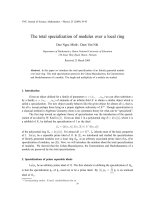The need to give international brands a local voice
Bạn đang xem bản rút gọn của tài liệu. Xem và tải ngay bản đầy đủ của tài liệu tại đây (113.02 KB, 8 trang )
OUTLINE
TOPIC: The need to give international brands a local voice.
Introduction
I. Overview of brands
1.1.Definition of brands
1.2. Benefit of brands
- Benefits for manufactures
- Benefits for customers
1.3. Difference between international brands and local brands
a. International brands and local brands
b. Differences between international brands and local brands
II. The need to give international brands a local voice
2.1. Reasons for giving international brands a local voice
a. The differences in language, cultural and taste of each country
b. Local voices help company penetrate and expand international market
more easily.
2.2 Benefits of giving international brands a local voice
a. Approach customers more easy and the customer will know to the
brand of them more than
b. Easier to improve clients’ awareness about a company
c. Have more advantages in competing with other companies
III. Difficulties in giving international brands a local voice and some
solutions.
3.1 Difficulties in giving international brands a local voice
3.2 Some solutions.
Conclusion
Introduction
Managers today are very much interested in brands, especially in international
economic integration and regions. Brand is not only a sign to distinguish goods and
services from businesses and other organizations, but also it is a basis for affirming
position’s business on market, reputation and image ’s business in customer’s
mind. Branding is a process which requires efforts and the appropriate investment
of business.
Furthermore, businesses are increasingly expanding their operations, setting up or
acquiring companies in other countries. However, investing oversea is not simply
at all because they have to face with the differences in environment, culture,
regions and customer’s habits. This makes manufacturers need to find out the
procedures as well as brand strategies to adapt new markets effectively. In order to
be successful, a global brand should seek to become a part of the local culture,
adapt to the unique needs, values and desires of the population. Giving
international brands a local voice is useful way which brand managers should
consider.
Therefore, we talk about topic “The need to give international brands a local
voice”.
I. Overview of brands
1.1. Definition of brands
The American Marketing Association (AMA) defines a brand as "a name, term,
sign, symbol or design, or a combination intended to identify the goods and
services of one seller or group sellers and to differentiate them from those of other
sellers”.
1.2. Benefits of brands
Benefits for manufactures
Brand helps building corporate image and products in customer’s mind. As a brand
first appeared on market, it absolutely does not have to be a certain image in
customer’s mind. The attributes of goods such as shape, size, color, or after-sale
service is a prerequisite for consumers choosing them. Over time, with
experience in using and brand messages that convey to customers, the position and
image of the goods is gradually positioning in the customer's mind.
Brand as a promise between businesses and customers. Customers believe in the
brand because we believe in quality products, superior service and a clear
positioning of the business while providing goods for users to create a special
personal value. The message that the brand launched in advertisements, slogans,
logos always generate excitement, attract customers, its contents are as certain
implicit commitment of the business of quality goods or the potential benefits from
the use of goods.
As the brand has been accepted, it helps business to access markets more easily,
even if it is a new merchandise category. Opportunity to penetrate and dominate
the market always opens before the strong brands.
Goods bearing a well-known brand can be sold more products and higher prices
than similar goods but unfamiliar brands.
Strong brand will attract investments and increase your customer relations. Brands
are intangible assets and very valuable.
Benefits for customers
Brand helps customers to select suitable goods in a variety of similar goods and
identify the source and origin of the goods.
Brand contributes to an individual's value to the customers. They feel luxurious,
highlights and class.
Brand creates a psychological assured of quality and reduces risks in consumption.
1.3 Difference between international brands and local brands
a. International brands and local brands
- Local brands are ‘collection of community associations on local character
and image by objects which it owns, such as history, social and economic
development, human, geographical characteristics, the destination, the
business environment, the movement and dynamic national, values such as
friendliness, quality, innovation ’’
- An international brand is defined as the worldwide use of a name, term, sign,
symbol, design, or combination thereof intended to identify goods or
services of one seller and to differ them from those of competitors.
b. Many differences between international brands and local brands
• The market scale: The main difference between international brands and
local brands would be its market presence where the local brands are
concentrated on tapping the customers of a particular region while the
international brands caters the needs of customers from various countries.
- Local brands: This type of brand is a brand that sold their product or
marketed their brand’s product in a small or restricted geographical area.
This type of brand only can found in the one country or region. It may also
be a brand that is developed for a specific national market, however the
amazing things is the local brand is more often being done by the consumers
than by the producers.
- International brands: International brands can be defined as a brand which
perceived to reflect the same set of values around the world. The
International brands were more focusing on enduring relationship with
customers across countries and cultures. Nowadays there were many of the
international brands such as Facebook, Apple, Coca cola, McDonald’s and
Sony. These brands are selling the similar product in the multiple markets
and it also can be considered as successful global brands.
• Brand strategy: The strategies that being used of these our brands also will
be different. Brand strategy is aimed on influencing people perception about
the brand such as they were persuaded to act in a certain manner
- Local brands: The local brand may use many strategies in order to makes
their brand is being aware by the consumer. The local brands were a brand
that easy to develop. They have used brand strategy by knowing their
customer need and want and the relevant brand name according to their
culture. The local brand has to create a modified branding if the product that
they sell were similar with the other products. The uniqueness of the brand
name or sign may attract the consumer attention.
- International brands: The International brands can use many strategies, for
example the broad strategy areas that can be used are the brand domain.
These brand domains are experts in one or more of the aspects. In order to
use this kind of strategy the person must have an intimate knowledge, not
only about the technologies shaping but also the pertinent customer behavior
and needs.
II. The need to give international brands a local voice.
2.1. Reasons for giving international brands a local voice.
There are some reasons why international brands need a local voice:
a. The differences in language, cultural and taste of each country
Business want to give a brand to the world is very difficult if they don’t have
knowledge of the culture and language of other countries. Working overseas will
bring with it some cultural challenges. New language, customs and ways of doing
business are things you will need to consider before you enter a new country.
Cultural differences are the variations in the way of life, beliefs, traditions and laws
between different countries, religions, societies and people. Culture has far
reaching implications for your branding, negotiation tactics, marketing approach,
and expectations.
Example: About Toyota Company, they failed to sell “Inova” cars in Spain’s
market because “Invova” means “do not move” in Spain. .
b. Local voices help company penetrate and expand international market
more easily.
In order to expand the sales of current products in markets where their products are
already being sold, marketers utilize market penetration strategies such as cutting
prices, increasing advertising, obtaining better store or shelf positions for their
products, or innovative distribution tactics. If exporting to a new market you need
to be aware of cultural differences between yourself and your international
business partners. Familiarity with customs and etiquette ranging from business
methods, dress and diet to history and religious customs will improve your chance
of success.
2.2 The benefits of giving international brands a local voice.
The following things are considered as the benefits of giving international brands a
local voice, which determine the success and life cycle of a product.
a. Approach customers more easy and the customer will know to the brand of them
more.
Firstly, international brands integrate in a local voice to attract more customers.
Based on the project of making international brands more familiar with local
customers, awareness of concerning cultural factors is raised to meet the demand
of local customers. Considerably, it is an effective way to boost international brand
recognition. As psycho of customers or consumers is concerned with fitted
customs, sale of products will surely soar. Thus, the strength of international
brands is improved.
b. Easier to improve clients’ awareness about a company
Giving international brands a local voice helps companies easier to improve
clients’ awareness about a company. When brands attract more customers, the sale
increase will be inevitable. More customers mean more brand loyalty. Therefore,
the market segment of brands will be flattered so earnings of these brands will
upsurge. Moreover, companies will afford more effective promotion campaigns or
advertisements. On the other hands, the fact that more people decide to consume
these products will foster the word-of-mouth advertisement which is very feasible
and strong in Vietnam.
c. Have more advantages in competing with other companies.
Last but not least, international brands integrated in a local voice create more
advantages in competing with other companies. Based on the increasing success
and attraction towards local customers or consumers, these brands are certainly
strengthened, which weakens the other competitors’ brands. Furthermore, the
advantage of market segment, mounting brand loyalty and the advertising support
from large number of consumers in word-of-mouth advertisement will overwhelm
their competitors.
2.3 Difficulties in giving international brands a local voice and some solutions
a. Difficulties in giving international brands a local voice
- Due to the differences in each language and culture, the way to get your message
from others business is also difficult. To convey the success of the brand to local
people, enterprises need to have a thorough study of culture, local lifestyle.
- The differences in people's awareness of each local cause a lot of problems in
communicating information. We should do some research about countries, local
brands which have been used and have not been registered the protection
- The international brand to every local business is to work with local authorities
there. Find out in the country, local brands that have been used and have been
registered for protection in order to avoid disputes.
It takes so many fees for doing these activities.
b. Some solutions
- Learn more about the culture as well as habits of local people. International
brand’s products need to be design for meeting the needs (features, requires,
demand) of each country. Advertising strategies should be consistent with the
culture of certain customer groups.
For example: A well-known footwear company in Vietnam intends to develop its
brand in Africa. Business must know that the climate is very hot here, African
people often wear nothing when they walk. Therefore, to sell shoes here, business
needs to design special model for them to protect them from high heat.
- Keep one logo for all countries but slogan is possible different between countries.
Businesses also have to select a particular slogan to fit with the culture of the
local people and make sure that the customers understand their messages clearly.
For example: In Vietnam, when he heard the slogan "Vietnam foot cradling" it is
easy to realize that the slogan but make sure if Biti’s develops its brand in the
world, certainly slogan of Biti’s must be changed.
- Showing your contribution to local areas through company’s policies.
By public relations policies such as charity, donations, scholarships for students ,
the brand of company will be recognized well and attract people easily. They also
should hire local labors for factories.
For example: In recent years, Vinamilk has Initiated a variety of Funds as "Funds 1
million trees for Vietnam", "Towering Milk Fund Vietnam"; "nurturing Talents
Scholarship Fund Vinamilk Vietnam" with the amount of ten billion.
- Training professional and knowledgeable staffs about the local culture to
provide the brand strategy which match each locality.
Conclusion
Conclusion, a local voice is very useful for company. Most of all, it is one of
important elements help develop brands. It helps penetrate a new market, expand
existing market more easily. However it is not always successful if the companies
do not pay attention to research local markets carefully.









